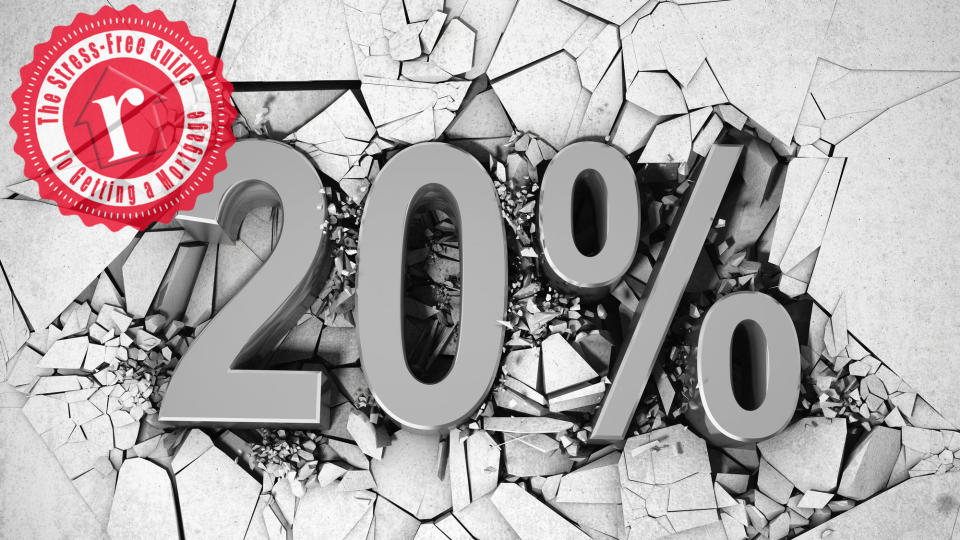The Lowdown on Down Payments: Everything a Home Buyer Needs to Know
Oleksii Glushenkov/iStock; realtor.com
Ask most people what’s the biggest obstacle to buying a home, and hands down they’ll say it’s scraping together enough money for a down payment. But understand a key point: This is not a separate and distinct issue from landing a mortgage. Lenders, after all, like to see clients lay down a sizable chunk of change before they fork over a mortgage, because this shows you have skin in the game and lowers the odds that you’ll default on your loan. So how large a down payment do you really need?
This second installment in our Stress-Free Guide to Getting a Mortgage will fill you in on everything you need to know.
Why a 20% down payment is best
Most financial planners recommend that home buyers make a down payment amounting to 20% of the price of the home. So, with the national median home price hovering currently around $240,900, the average 20% down payment costs a whopping $48,180. Phew!
Sure, that’s a lot of cash, which may explain why one survey by NerdWallet of 2,000 Americans found that we spend an average of three years shoring up our finances before buying a home. But there’s good reason to start pinching pennies early: A 20% down payment enables you to avoid paying private mortgage insurance.
What is private mortgage insurance?
If you have good credit and can put at least 10% down, you can still qualify for a conventional loan. The catch? You’ll need to pay private mortgage insurance, a premium that protects the lender in case you default on the loan. PMI ranges from about 0.3% to 1.15% of your home loan. But with interest rates being as low as they are, buying now can be a smart move from a long-term savings perspective.
“Mortgage insurance has gained a negative connotation, but it enables many people to buy homes who wouldn’t otherwise be able to,” says Barbara Carrollo-Loeffler, director of consumer and residential lending at Provident Bank.
Another silver lining: Once you have at least 20% equity in your home, you can ask your lender to cancel your PMI. And once you have 22% equity, the lender is required to automatically cancel the coverage. (One caveat: Some lenders require homeowners to get a home appraisal before they’ll remove it.)
Of course, purchasing a home now also means that you’ll start gaining equity in the home, rather than continuing to burn money on rent. You can use realtor.com®’s Rent or Buy calculator to see how much you’ll save each month.
Don’t have 20% or even 10%? Here’s what to do
Don’t have that kind of cash lying around? You have options. Depending on your credit score and income, you could qualify for one of over 2,200 down payment assistance programs nationwide, which help out home buyers with low-interest loans, grants, and tax credits. While a certain portion is geared to low-income buyers, you don’t have to be down and out.
According to Jonathan Smoke, chief economist of realtor.com: “Most consumers do not know about these programs, and those that do assume it’s more difficult to get than it is.”
And the savings can be substantial: Home buyers who use down payment assistance programs save an average of $17,766 over the life of their loan, according to a report by RealtyTrac. But we’re talking even bigger cash in expensive housing markets such as Los Angeles, where the average down payment assistance is a handsome $40,598.
To find down payment assistance programs, you can search for your state on the Department of Housing and Urban Development website or using Bank of America’s recently launched database of local programs.
Another option is a government-backed mortgage, if you qualify. Federal Housing Administration loans let borrowers put down as little as 3.5%; if you or your spouse served in the military, you’re truly in luck: Veterans Affairs loans are available with 0% down. You’ll need to meet certain income and credit requirements—FHA loans call for a minimum credit score of 500, and VA loans require a minimum score of 620—but these loan programs could allow you to purchase a home with less than 20% down.
The downside to small down payments
While making a small down payment may seem dreamy, keep in mind that there are some drawbacks. For one, the amount of money you’re borrowing will obviously be larger, which means you’ll have to make larger monthly mortgage payments. Making matters worse, loans with down payments under 20% typically come with higher interest rates. Therefore, you’ll need to tighten your spending more than if you were making a 20% down payment, but that’s not necessarily a bad thing if it enables you to clinch the keys to a home now, is it?
To get a ballpark figure of the mortgage you can afford and how your down payment affects your finances, punch your salary and other numbers into a home affordability calculator. Then stay tuned next week to learn more about the next step: getting pre-approved for a home loan.
Are you still stressed? Or do you have more tips to help future homeowners chill out about their down payment? Let us know on House Talk.
The post The Lowdown on Down Payments: Everything a Home Buyer Needs to Know appeared first on Real Estate News and Advice - realtor.com.

 Yahoo Finance
Yahoo Finance 

